Strategic Management Case Study: Lego Group Analysis and Strategies
VerifiedAdded on 2020/01/15
|15
|4260
|223
Report
AI Summary
This report presents a comprehensive strategic analysis of the Lego Group, a prominent plastic toy manufacturing company based in Denmark. The analysis delves into the application of strategic management principles, examining the company's objectives, challenges, and the strategies employed to achieve its goals. The case study utilizes various analytical tools and methods, including PESTEL analysis, Porter's Five Forces, and others, to assess the macro and micro-environmental factors influencing Lego's performance. The report explores key questions related to the company's growth, competitive landscape, and future strategies, addressing issues such as market fluctuations, competitor actions, and the evolving demands of the toy industry. It also examines the company's ability to adapt to technological advancements and maintain its competitive edge in the global market. The analysis covers framing, labeling, and summarizing the case, providing insights into Lego's strengths, weaknesses, and strategic responses to market dynamics.

Strategic Management
1
1
Paraphrase This Document
Need a fresh take? Get an instant paraphrase of this document with our AI Paraphraser

Table of Contents
INTRODUCTION ...............................................................................................................................4
CASE ANALYSIS PROCESS.............................................................................................................4
2
INTRODUCTION ...............................................................................................................................4
CASE ANALYSIS PROCESS.............................................................................................................4
2
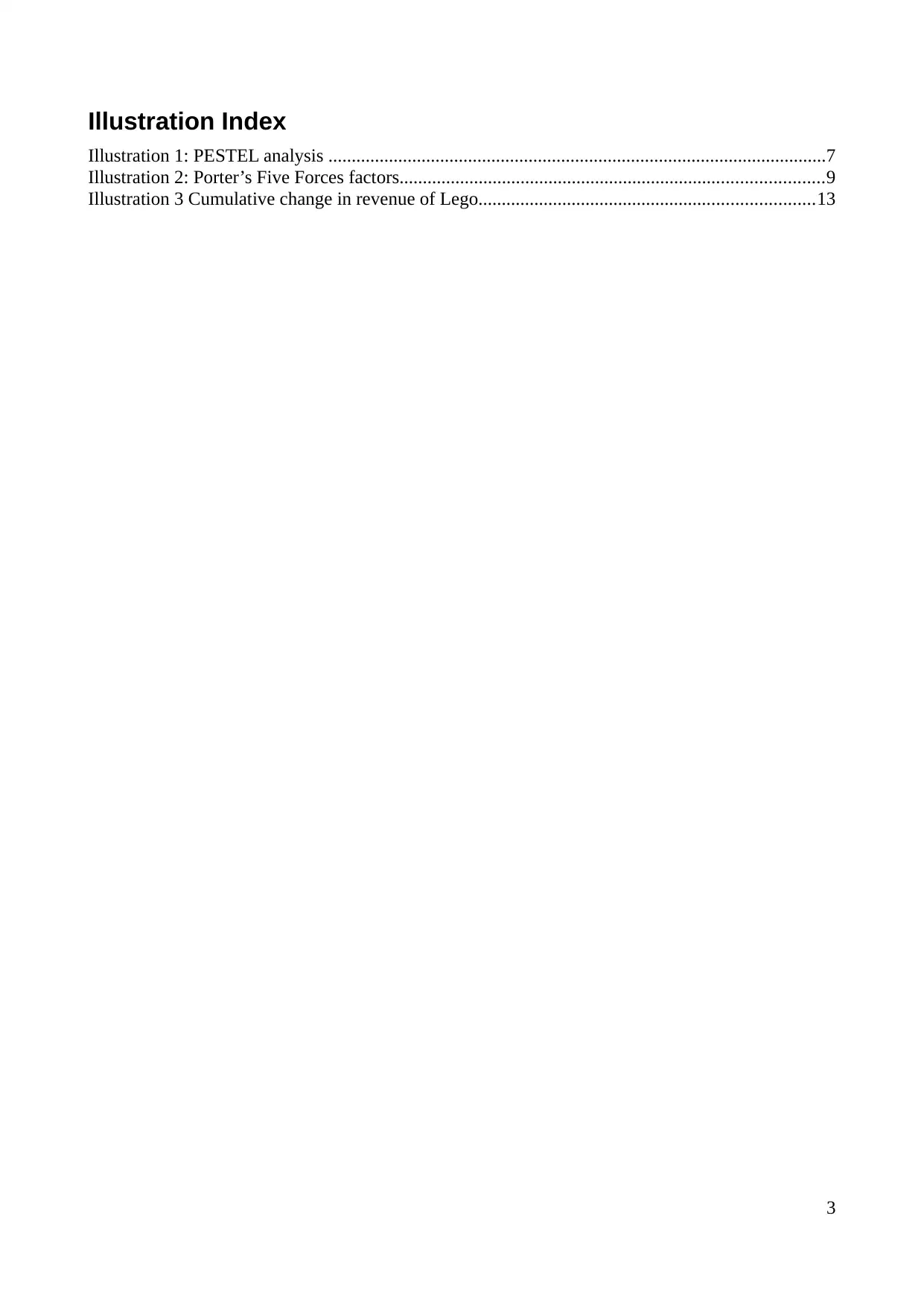
Illustration Index
Illustration 1: PESTEL analysis ...........................................................................................................7
Illustration 2: Porter’s Five Forces factors...........................................................................................9
Illustration 3 Cumulative change in revenue of Lego........................................................................13
3
Illustration 1: PESTEL analysis ...........................................................................................................7
Illustration 2: Porter’s Five Forces factors...........................................................................................9
Illustration 3 Cumulative change in revenue of Lego........................................................................13
3
⊘ This is a preview!⊘
Do you want full access?
Subscribe today to unlock all pages.

Trusted by 1+ million students worldwide
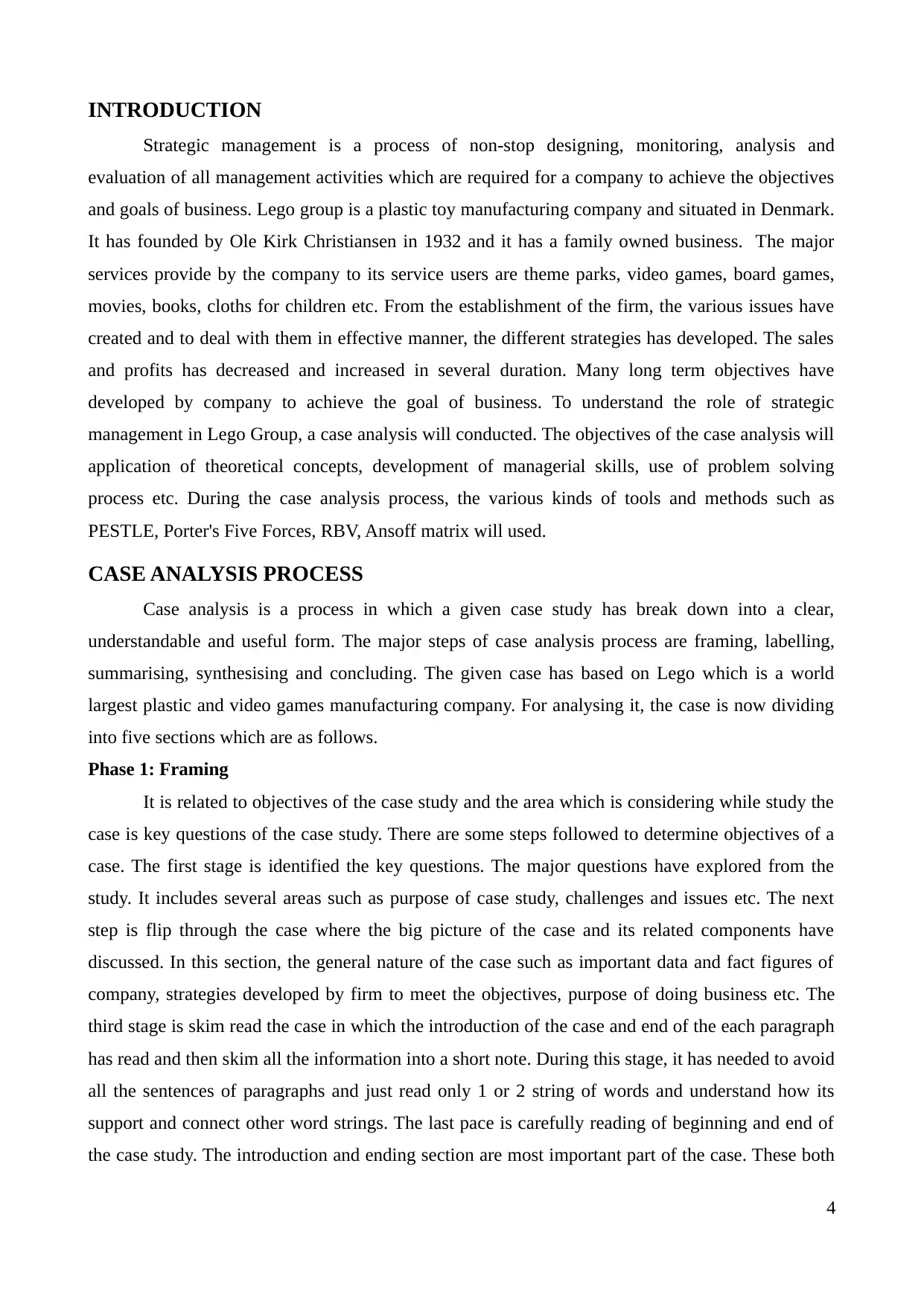
INTRODUCTION
Strategic management is a process of non-stop designing, monitoring, analysis and
evaluation of all management activities which are required for a company to achieve the objectives
and goals of business. Lego group is a plastic toy manufacturing company and situated in Denmark.
It has founded by Ole Kirk Christiansen in 1932 and it has a family owned business. The major
services provide by the company to its service users are theme parks, video games, board games,
movies, books, cloths for children etc. From the establishment of the firm, the various issues have
created and to deal with them in effective manner, the different strategies has developed. The sales
and profits has decreased and increased in several duration. Many long term objectives have
developed by company to achieve the goal of business. To understand the role of strategic
management in Lego Group, a case analysis will conducted. The objectives of the case analysis will
application of theoretical concepts, development of managerial skills, use of problem solving
process etc. During the case analysis process, the various kinds of tools and methods such as
PESTLE, Porter's Five Forces, RBV, Ansoff matrix will used.
CASE ANALYSIS PROCESS
Case analysis is a process in which a given case study has break down into a clear,
understandable and useful form. The major steps of case analysis process are framing, labelling,
summarising, synthesising and concluding. The given case has based on Lego which is a world
largest plastic and video games manufacturing company. For analysing it, the case is now dividing
into five sections which are as follows.
Phase 1: Framing
It is related to objectives of the case study and the area which is considering while study the
case is key questions of the case study. There are some steps followed to determine objectives of a
case. The first stage is identified the key questions. The major questions have explored from the
study. It includes several areas such as purpose of case study, challenges and issues etc. The next
step is flip through the case where the big picture of the case and its related components have
discussed. In this section, the general nature of the case such as important data and fact figures of
company, strategies developed by firm to meet the objectives, purpose of doing business etc. The
third stage is skim read the case in which the introduction of the case and end of the each paragraph
has read and then skim all the information into a short note. During this stage, it has needed to avoid
all the sentences of paragraphs and just read only 1 or 2 string of words and understand how its
support and connect other word strings. The last pace is carefully reading of beginning and end of
the case study. The introduction and ending section are most important part of the case. These both
4
Strategic management is a process of non-stop designing, monitoring, analysis and
evaluation of all management activities which are required for a company to achieve the objectives
and goals of business. Lego group is a plastic toy manufacturing company and situated in Denmark.
It has founded by Ole Kirk Christiansen in 1932 and it has a family owned business. The major
services provide by the company to its service users are theme parks, video games, board games,
movies, books, cloths for children etc. From the establishment of the firm, the various issues have
created and to deal with them in effective manner, the different strategies has developed. The sales
and profits has decreased and increased in several duration. Many long term objectives have
developed by company to achieve the goal of business. To understand the role of strategic
management in Lego Group, a case analysis will conducted. The objectives of the case analysis will
application of theoretical concepts, development of managerial skills, use of problem solving
process etc. During the case analysis process, the various kinds of tools and methods such as
PESTLE, Porter's Five Forces, RBV, Ansoff matrix will used.
CASE ANALYSIS PROCESS
Case analysis is a process in which a given case study has break down into a clear,
understandable and useful form. The major steps of case analysis process are framing, labelling,
summarising, synthesising and concluding. The given case has based on Lego which is a world
largest plastic and video games manufacturing company. For analysing it, the case is now dividing
into five sections which are as follows.
Phase 1: Framing
It is related to objectives of the case study and the area which is considering while study the
case is key questions of the case study. There are some steps followed to determine objectives of a
case. The first stage is identified the key questions. The major questions have explored from the
study. It includes several areas such as purpose of case study, challenges and issues etc. The next
step is flip through the case where the big picture of the case and its related components have
discussed. In this section, the general nature of the case such as important data and fact figures of
company, strategies developed by firm to meet the objectives, purpose of doing business etc. The
third stage is skim read the case in which the introduction of the case and end of the each paragraph
has read and then skim all the information into a short note. During this stage, it has needed to avoid
all the sentences of paragraphs and just read only 1 or 2 string of words and understand how its
support and connect other word strings. The last pace is carefully reading of beginning and end of
the case study. The introduction and ending section are most important part of the case. These both
4
Paraphrase This Document
Need a fresh take? Get an instant paraphrase of this document with our AI Paraphraser

sections have carried then essential information about the case. With the help of it, it can be easy to
analyse the important aspects of the study in well manner. Therefore, the above stated steps helps in
identify the objectives of the case study.
In the given case which has related to Lego Group Company, for analysing the objectives of
the study the above stated process has followed. From the these steps, the explore objectives from
the case are as follows.
Key questions
What was the ways adopting by Kjeld to maintain the continuous impressive growth
company?
Should Lego Company focus on the traditional brick or should it use its brand as a platform
to innovate in new areas?
What were the solutions of increase activeness of competitors and weak exchange rate of US
as compare to Danish Krone?
Would the young age and discussion about background of new CEO Jorgen Vig Knudstrop
in the press will enable him to handle the command of business or not?
How could Lego Group compete with China which production cost of toys was low as
compare to Lego? What would be the strategies adopted by Jorgen to continued success of the Lego Group?
Flipping and skimming
Lego is a family own business and deal in manufacturing of plastic toys and clothing for the
children. After the some time of establishment, company had expended its business at international
level and increased the number of employees. Due to oil crisis, world economy had slow down but
firm had deal with that challenge by introduced the new products in the market. By developing the
various objectives, Kjeld was maintaining the impressive growth of the business. On the other hand,
in the duration of crisis and unsustainable turnarounds, Lego was starting cost cutting and
restructuring programs. There were various reasons of fluctuations in the profits and sales. By
developing the major strategic developments, company was again getting back on track. The period
of 2008 and 2009 was the decisive moment in which the highest growth of the company was
recording.
Beginning of case
From the annual report of Lego, it has found that in 2009, the sales of company products is
11.661 million DKK and operating profit is about 3002 million DKK. The sales has increased by
22% and profit by 50% after 2008. Even 2008 was also a great year for Lego because in that period,
the sales was increasing by 19%. The new innovations, new strategies and the long term objectives
5
analyse the important aspects of the study in well manner. Therefore, the above stated steps helps in
identify the objectives of the case study.
In the given case which has related to Lego Group Company, for analysing the objectives of
the study the above stated process has followed. From the these steps, the explore objectives from
the case are as follows.
Key questions
What was the ways adopting by Kjeld to maintain the continuous impressive growth
company?
Should Lego Company focus on the traditional brick or should it use its brand as a platform
to innovate in new areas?
What were the solutions of increase activeness of competitors and weak exchange rate of US
as compare to Danish Krone?
Would the young age and discussion about background of new CEO Jorgen Vig Knudstrop
in the press will enable him to handle the command of business or not?
How could Lego Group compete with China which production cost of toys was low as
compare to Lego? What would be the strategies adopted by Jorgen to continued success of the Lego Group?
Flipping and skimming
Lego is a family own business and deal in manufacturing of plastic toys and clothing for the
children. After the some time of establishment, company had expended its business at international
level and increased the number of employees. Due to oil crisis, world economy had slow down but
firm had deal with that challenge by introduced the new products in the market. By developing the
various objectives, Kjeld was maintaining the impressive growth of the business. On the other hand,
in the duration of crisis and unsustainable turnarounds, Lego was starting cost cutting and
restructuring programs. There were various reasons of fluctuations in the profits and sales. By
developing the major strategic developments, company was again getting back on track. The period
of 2008 and 2009 was the decisive moment in which the highest growth of the company was
recording.
Beginning of case
From the annual report of Lego, it has found that in 2009, the sales of company products is
11.661 million DKK and operating profit is about 3002 million DKK. The sales has increased by
22% and profit by 50% after 2008. Even 2008 was also a great year for Lego because in that period,
the sales was increasing by 19%. The new innovations, new strategies and the long term objectives
5
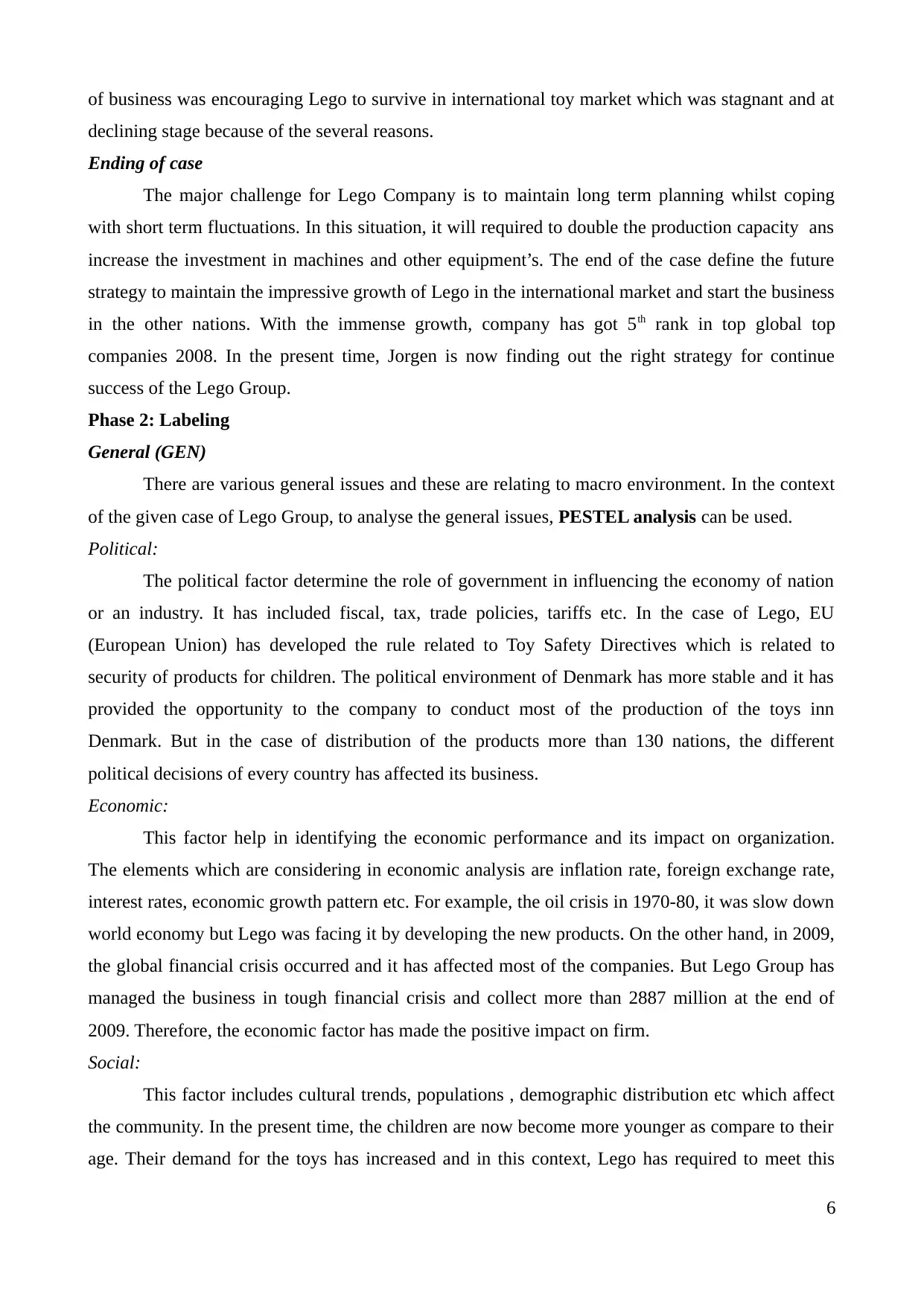
of business was encouraging Lego to survive in international toy market which was stagnant and at
declining stage because of the several reasons.
Ending of case
The major challenge for Lego Company is to maintain long term planning whilst coping
with short term fluctuations. In this situation, it will required to double the production capacity ans
increase the investment in machines and other equipment’s. The end of the case define the future
strategy to maintain the impressive growth of Lego in the international market and start the business
in the other nations. With the immense growth, company has got 5th rank in top global top
companies 2008. In the present time, Jorgen is now finding out the right strategy for continue
success of the Lego Group.
Phase 2: Labeling
General (GEN)
There are various general issues and these are relating to macro environment. In the context
of the given case of Lego Group, to analyse the general issues, PESTEL analysis can be used.
Political:
The political factor determine the role of government in influencing the economy of nation
or an industry. It has included fiscal, tax, trade policies, tariffs etc. In the case of Lego, EU
(European Union) has developed the rule related to Toy Safety Directives which is related to
security of products for children. The political environment of Denmark has more stable and it has
provided the opportunity to the company to conduct most of the production of the toys inn
Denmark. But in the case of distribution of the products more than 130 nations, the different
political decisions of every country has affected its business.
Economic:
This factor help in identifying the economic performance and its impact on organization.
The elements which are considering in economic analysis are inflation rate, foreign exchange rate,
interest rates, economic growth pattern etc. For example, the oil crisis in 1970-80, it was slow down
world economy but Lego was facing it by developing the new products. On the other hand, in 2009,
the global financial crisis occurred and it has affected most of the companies. But Lego Group has
managed the business in tough financial crisis and collect more than 2887 million at the end of
2009. Therefore, the economic factor has made the positive impact on firm.
Social:
This factor includes cultural trends, populations , demographic distribution etc which affect
the community. In the present time, the children are now become more younger as compare to their
age. Their demand for the toys has increased and in this context, Lego has required to meet this
6
declining stage because of the several reasons.
Ending of case
The major challenge for Lego Company is to maintain long term planning whilst coping
with short term fluctuations. In this situation, it will required to double the production capacity ans
increase the investment in machines and other equipment’s. The end of the case define the future
strategy to maintain the impressive growth of Lego in the international market and start the business
in the other nations. With the immense growth, company has got 5th rank in top global top
companies 2008. In the present time, Jorgen is now finding out the right strategy for continue
success of the Lego Group.
Phase 2: Labeling
General (GEN)
There are various general issues and these are relating to macro environment. In the context
of the given case of Lego Group, to analyse the general issues, PESTEL analysis can be used.
Political:
The political factor determine the role of government in influencing the economy of nation
or an industry. It has included fiscal, tax, trade policies, tariffs etc. In the case of Lego, EU
(European Union) has developed the rule related to Toy Safety Directives which is related to
security of products for children. The political environment of Denmark has more stable and it has
provided the opportunity to the company to conduct most of the production of the toys inn
Denmark. But in the case of distribution of the products more than 130 nations, the different
political decisions of every country has affected its business.
Economic:
This factor help in identifying the economic performance and its impact on organization.
The elements which are considering in economic analysis are inflation rate, foreign exchange rate,
interest rates, economic growth pattern etc. For example, the oil crisis in 1970-80, it was slow down
world economy but Lego was facing it by developing the new products. On the other hand, in 2009,
the global financial crisis occurred and it has affected most of the companies. But Lego Group has
managed the business in tough financial crisis and collect more than 2887 million at the end of
2009. Therefore, the economic factor has made the positive impact on firm.
Social:
This factor includes cultural trends, populations , demographic distribution etc which affect
the community. In the present time, the children are now become more younger as compare to their
age. Their demand for the toys has increased and in this context, Lego has required to meet this
6
⊘ This is a preview!⊘
Do you want full access?
Subscribe today to unlock all pages.

Trusted by 1+ million students worldwide
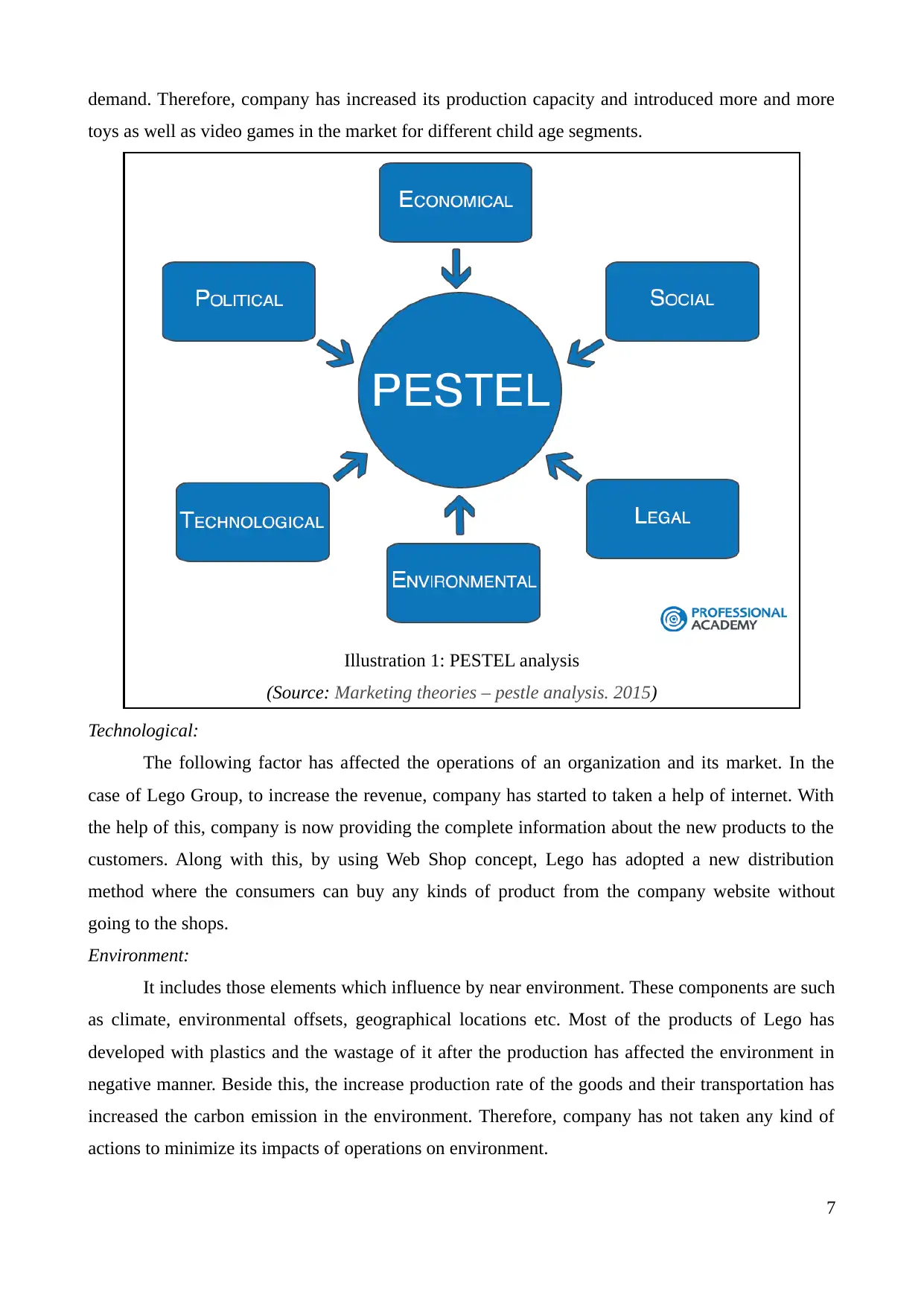
demand. Therefore, company has increased its production capacity and introduced more and more
toys as well as video games in the market for different child age segments.
Illustration 1: PESTEL analysis
(Source: Marketing theories – pestle analysis. 2015)
Technological:
The following factor has affected the operations of an organization and its market. In the
case of Lego Group, to increase the revenue, company has started to taken a help of internet. With
the help of this, company is now providing the complete information about the new products to the
customers. Along with this, by using Web Shop concept, Lego has adopted a new distribution
method where the consumers can buy any kinds of product from the company website without
going to the shops.
Environment:
It includes those elements which influence by near environment. These components are such
as climate, environmental offsets, geographical locations etc. Most of the products of Lego has
developed with plastics and the wastage of it after the production has affected the environment in
negative manner. Beside this, the increase production rate of the goods and their transportation has
increased the carbon emission in the environment. Therefore, company has not taken any kind of
actions to minimize its impacts of operations on environment.
7
toys as well as video games in the market for different child age segments.
Illustration 1: PESTEL analysis
(Source: Marketing theories – pestle analysis. 2015)
Technological:
The following factor has affected the operations of an organization and its market. In the
case of Lego Group, to increase the revenue, company has started to taken a help of internet. With
the help of this, company is now providing the complete information about the new products to the
customers. Along with this, by using Web Shop concept, Lego has adopted a new distribution
method where the consumers can buy any kinds of product from the company website without
going to the shops.
Environment:
It includes those elements which influence by near environment. These components are such
as climate, environmental offsets, geographical locations etc. Most of the products of Lego has
developed with plastics and the wastage of it after the production has affected the environment in
negative manner. Beside this, the increase production rate of the goods and their transportation has
increased the carbon emission in the environment. Therefore, company has not taken any kind of
actions to minimize its impacts of operations on environment.
7
Paraphrase This Document
Need a fresh take? Get an instant paraphrase of this document with our AI Paraphraser
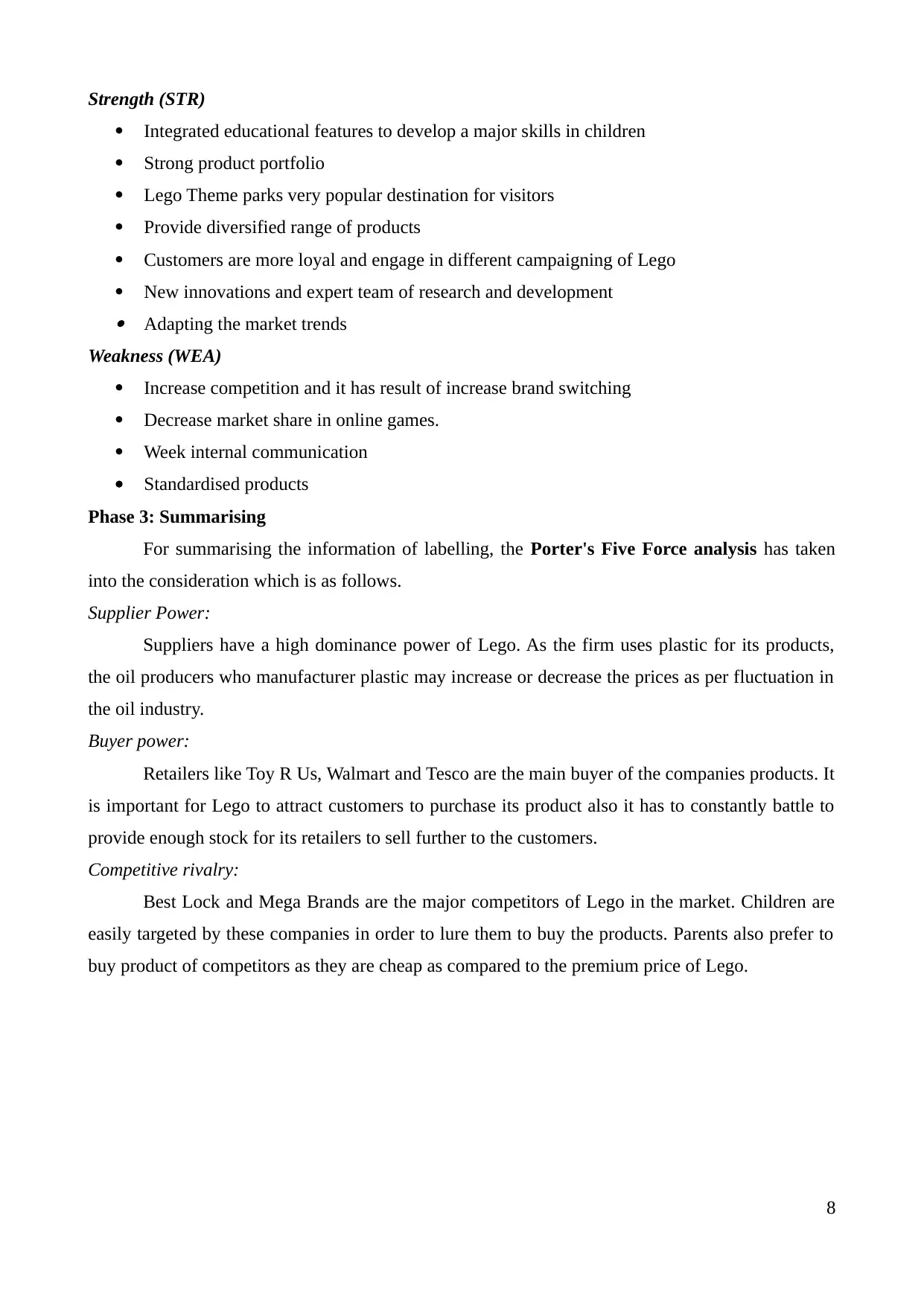
Strength (STR)
Integrated educational features to develop a major skills in children
Strong product portfolio
Lego Theme parks very popular destination for visitors
Provide diversified range of products
Customers are more loyal and engage in different campaigning of Lego
New innovations and expert team of research and development Adapting the market trends
Weakness (WEA)
Increase competition and it has result of increase brand switching
Decrease market share in online games.
Week internal communication
Standardised products
Phase 3: Summarising
For summarising the information of labelling, the Porter's Five Force analysis has taken
into the consideration which is as follows.
Supplier Power:
Suppliers have a high dominance power of Lego. As the firm uses plastic for its products,
the oil producers who manufacturer plastic may increase or decrease the prices as per fluctuation in
the oil industry.
Buyer power:
Retailers like Toy R Us, Walmart and Tesco are the main buyer of the companies products. It
is important for Lego to attract customers to purchase its product also it has to constantly battle to
provide enough stock for its retailers to sell further to the customers.
Competitive rivalry:
Best Lock and Mega Brands are the major competitors of Lego in the market. Children are
easily targeted by these companies in order to lure them to buy the products. Parents also prefer to
buy product of competitors as they are cheap as compared to the premium price of Lego.
8
Integrated educational features to develop a major skills in children
Strong product portfolio
Lego Theme parks very popular destination for visitors
Provide diversified range of products
Customers are more loyal and engage in different campaigning of Lego
New innovations and expert team of research and development Adapting the market trends
Weakness (WEA)
Increase competition and it has result of increase brand switching
Decrease market share in online games.
Week internal communication
Standardised products
Phase 3: Summarising
For summarising the information of labelling, the Porter's Five Force analysis has taken
into the consideration which is as follows.
Supplier Power:
Suppliers have a high dominance power of Lego. As the firm uses plastic for its products,
the oil producers who manufacturer plastic may increase or decrease the prices as per fluctuation in
the oil industry.
Buyer power:
Retailers like Toy R Us, Walmart and Tesco are the main buyer of the companies products. It
is important for Lego to attract customers to purchase its product also it has to constantly battle to
provide enough stock for its retailers to sell further to the customers.
Competitive rivalry:
Best Lock and Mega Brands are the major competitors of Lego in the market. Children are
easily targeted by these companies in order to lure them to buy the products. Parents also prefer to
buy product of competitors as they are cheap as compared to the premium price of Lego.
8
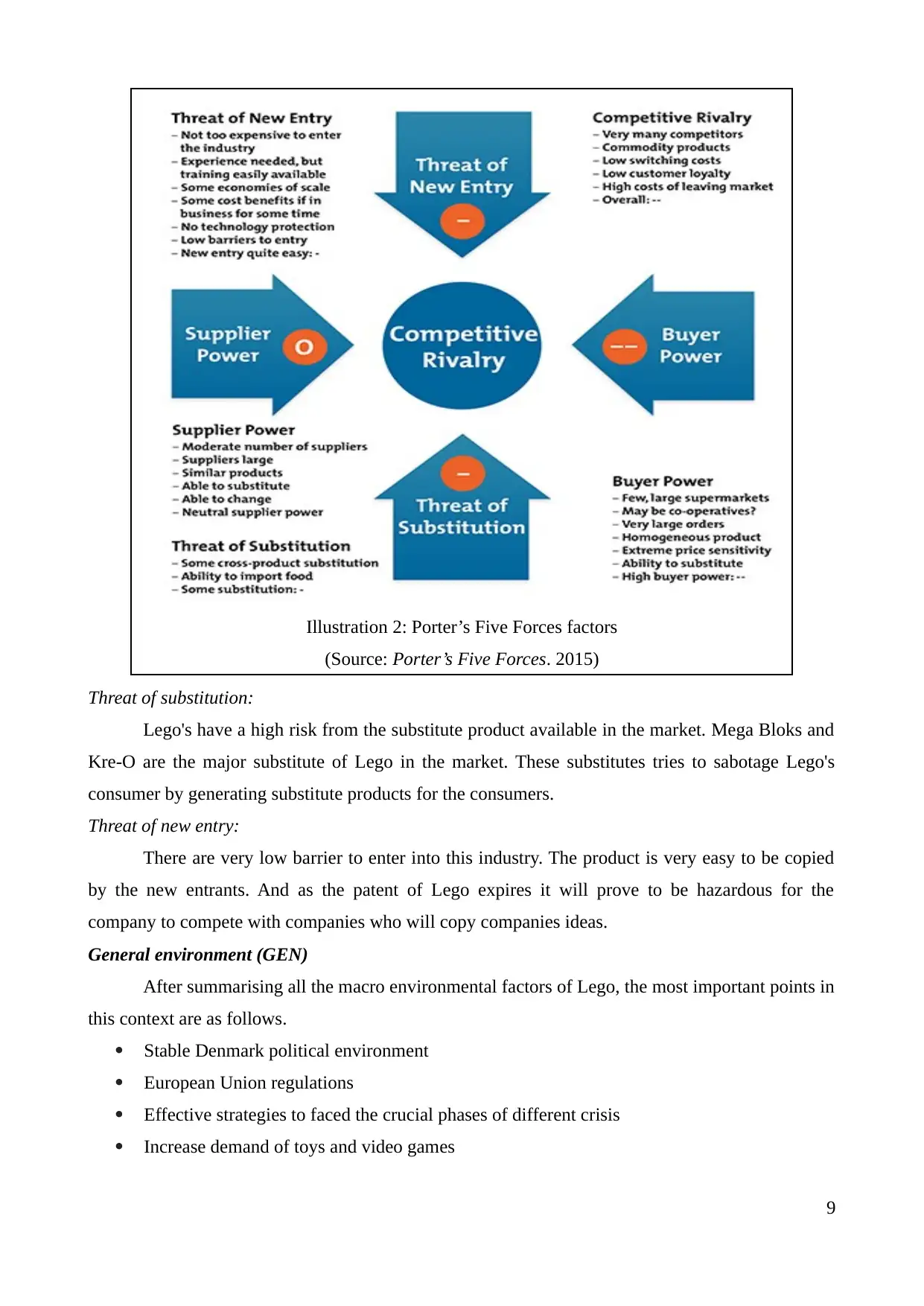
Illustration 2: Porter’s Five Forces factors
(Source: Porter’s Five Forces. 2015)
Threat of substitution:
Lego's have a high risk from the substitute product available in the market. Mega Bloks and
Kre-O are the major substitute of Lego in the market. These substitutes tries to sabotage Lego's
consumer by generating substitute products for the consumers.
Threat of new entry:
There are very low barrier to enter into this industry. The product is very easy to be copied
by the new entrants. And as the patent of Lego expires it will prove to be hazardous for the
company to compete with companies who will copy companies ideas.
General environment (GEN)
After summarising all the macro environmental factors of Lego, the most important points in
this context are as follows.
Stable Denmark political environment
European Union regulations
Effective strategies to faced the crucial phases of different crisis
Increase demand of toys and video games
9
(Source: Porter’s Five Forces. 2015)
Threat of substitution:
Lego's have a high risk from the substitute product available in the market. Mega Bloks and
Kre-O are the major substitute of Lego in the market. These substitutes tries to sabotage Lego's
consumer by generating substitute products for the consumers.
Threat of new entry:
There are very low barrier to enter into this industry. The product is very easy to be copied
by the new entrants. And as the patent of Lego expires it will prove to be hazardous for the
company to compete with companies who will copy companies ideas.
General environment (GEN)
After summarising all the macro environmental factors of Lego, the most important points in
this context are as follows.
Stable Denmark political environment
European Union regulations
Effective strategies to faced the crucial phases of different crisis
Increase demand of toys and video games
9
⊘ This is a preview!⊘
Do you want full access?
Subscribe today to unlock all pages.

Trusted by 1+ million students worldwide

Adopt new technologies for new innovation and fast distribution of the products
Competition
The major competitors of Lego Group at present time are Mattel and Hasbro. These all are
manufacturing toys and electronic video games which are like by the customers. This thing has
increased the competition level in the toy industry and bring the changes in the trends of gaming.
Strengths
Emotional appealing brand
High quality products
Ability to adopt the new market trends Globally recognized brand
Weakness
Loss of identity
Diversification of markets
High production prices
Standardization
Weak internal communication
Phase 4: Synthesising
Ansoff matrix: With the help of Ansoff matrix, a company can represent its products into the
market in more effective manner. There are four different growth strategies: market penetration,
market development, product development and diversification. There are two dimensions of the
following matrix: markets and product which are new and existing. In the case of market
penetration strategy, a firm wants to achieve the growth from existing product in the present market
with the intention of increase market share. On the other hand, organizations have looked the
growth by introduced the existing goods in the new market. Beside this, for looking the
opportunities of growth, company can develop new products for the existing market area and for
this, product development strategy can be adopted. With the help of diversification strategy, an
enterprise can achieve the growth by developing new goods for new markets.
From the above analysis, it has been found that Lego has followed three strategies: market
penetration, product development and diversification. The intention behind adopting the following
strategies are increase market share, sales and profit with the time.
Question Option/Hypothesis Decision Criteria Pros Cons
What was the
ways adopting by
Objectives:
SMART/Simple
The dimensions
used in selecting
The advantage of
adopting
To meet the
objectives, the
10
Competition
The major competitors of Lego Group at present time are Mattel and Hasbro. These all are
manufacturing toys and electronic video games which are like by the customers. This thing has
increased the competition level in the toy industry and bring the changes in the trends of gaming.
Strengths
Emotional appealing brand
High quality products
Ability to adopt the new market trends Globally recognized brand
Weakness
Loss of identity
Diversification of markets
High production prices
Standardization
Weak internal communication
Phase 4: Synthesising
Ansoff matrix: With the help of Ansoff matrix, a company can represent its products into the
market in more effective manner. There are four different growth strategies: market penetration,
market development, product development and diversification. There are two dimensions of the
following matrix: markets and product which are new and existing. In the case of market
penetration strategy, a firm wants to achieve the growth from existing product in the present market
with the intention of increase market share. On the other hand, organizations have looked the
growth by introduced the existing goods in the new market. Beside this, for looking the
opportunities of growth, company can develop new products for the existing market area and for
this, product development strategy can be adopted. With the help of diversification strategy, an
enterprise can achieve the growth by developing new goods for new markets.
From the above analysis, it has been found that Lego has followed three strategies: market
penetration, product development and diversification. The intention behind adopting the following
strategies are increase market share, sales and profit with the time.
Question Option/Hypothesis Decision Criteria Pros Cons
What was the
ways adopting by
Objectives:
SMART/Simple
The dimensions
used in selecting
The advantage of
adopting
To meet the
objectives, the
10
Paraphrase This Document
Need a fresh take? Get an instant paraphrase of this document with our AI Paraphraser
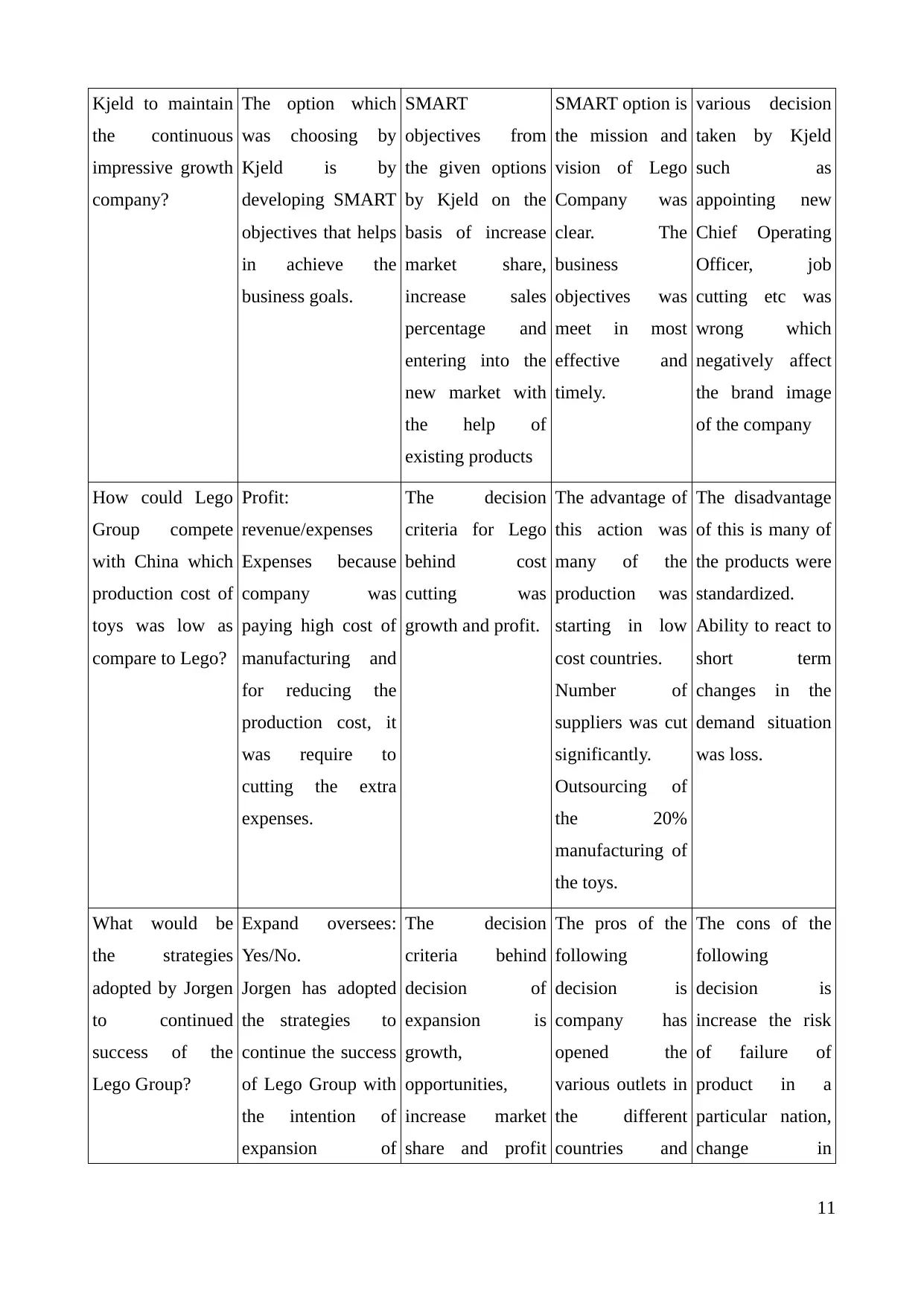
Kjeld to maintain
the continuous
impressive growth
company?
The option which
was choosing by
Kjeld is by
developing SMART
objectives that helps
in achieve the
business goals.
SMART
objectives from
the given options
by Kjeld on the
basis of increase
market share,
increase sales
percentage and
entering into the
new market with
the help of
existing products
SMART option is
the mission and
vision of Lego
Company was
clear. The
business
objectives was
meet in most
effective and
timely.
various decision
taken by Kjeld
such as
appointing new
Chief Operating
Officer, job
cutting etc was
wrong which
negatively affect
the brand image
of the company
How could Lego
Group compete
with China which
production cost of
toys was low as
compare to Lego?
Profit:
revenue/expenses
Expenses because
company was
paying high cost of
manufacturing and
for reducing the
production cost, it
was require to
cutting the extra
expenses.
The decision
criteria for Lego
behind cost
cutting was
growth and profit.
The advantage of
this action was
many of the
production was
starting in low
cost countries.
Number of
suppliers was cut
significantly.
Outsourcing of
the 20%
manufacturing of
the toys.
The disadvantage
of this is many of
the products were
standardized.
Ability to react to
short term
changes in the
demand situation
was loss.
What would be
the strategies
adopted by Jorgen
to continued
success of the
Lego Group?
Expand oversees:
Yes/No.
Jorgen has adopted
the strategies to
continue the success
of Lego Group with
the intention of
expansion of
The decision
criteria behind
decision of
expansion is
growth,
opportunities,
increase market
share and profit
The pros of the
following
decision is
company has
opened the
various outlets in
the different
countries and
The cons of the
following
decision is
increase the risk
of failure of
product in a
particular nation,
change in
11
the continuous
impressive growth
company?
The option which
was choosing by
Kjeld is by
developing SMART
objectives that helps
in achieve the
business goals.
SMART
objectives from
the given options
by Kjeld on the
basis of increase
market share,
increase sales
percentage and
entering into the
new market with
the help of
existing products
SMART option is
the mission and
vision of Lego
Company was
clear. The
business
objectives was
meet in most
effective and
timely.
various decision
taken by Kjeld
such as
appointing new
Chief Operating
Officer, job
cutting etc was
wrong which
negatively affect
the brand image
of the company
How could Lego
Group compete
with China which
production cost of
toys was low as
compare to Lego?
Profit:
revenue/expenses
Expenses because
company was
paying high cost of
manufacturing and
for reducing the
production cost, it
was require to
cutting the extra
expenses.
The decision
criteria for Lego
behind cost
cutting was
growth and profit.
The advantage of
this action was
many of the
production was
starting in low
cost countries.
Number of
suppliers was cut
significantly.
Outsourcing of
the 20%
manufacturing of
the toys.
The disadvantage
of this is many of
the products were
standardized.
Ability to react to
short term
changes in the
demand situation
was loss.
What would be
the strategies
adopted by Jorgen
to continued
success of the
Lego Group?
Expand oversees:
Yes/No.
Jorgen has adopted
the strategies to
continue the success
of Lego Group with
the intention of
expansion of
The decision
criteria behind
decision of
expansion is
growth,
opportunities,
increase market
share and profit
The pros of the
following
decision is
company has
opened the
various outlets in
the different
countries and
The cons of the
following
decision is
increase the risk
of failure of
product in a
particular nation,
change in
11

business in
oversees.
and achieve
business
objectives.
start to deal in
new sector such
as film, clothing
etc.
political
environment,
rules and
regulations of the
government etc.
Whittington Four School theory has related to the strategy formulation. Under this
framework, there are four perspective of strategy: classical, processual, evolutionary and
systematic. In classical approach, the intention behind formulation of strategy is profit
maximization. In this, it has assume that business environment to be predictable therefore with the
help of rational and logical approach will enable the companies to achieve the objectives and aim of
business. On the other hand, evolutionary strategies are formulating with the purpose of survive the
market. Such type of strategies are short term and not conduct the business for long time. Beside
this, processual strategies are developing when the objectives are not clear. The strategic
formulation has based on perceptions and internal factors of the company. While, in the case of
systematic strategy, it has developed on the basis of the different external factors such as culture,
attitude of the people etc. In the context of Lego, the applicable Whittington Four School Theory is
classical because the objectives of the company is profit maximization. The internal factors have
considered during formulation of strategies. The major perspective behind this is adopt low cost
leadership so that the cost of the goods can be reduced.
Another method of developing the strategy for an organization is Mintzberg 5 Ps theory.
Each P has the different approach which helped in developed the new strategy. With the help of this,
a company can take the advantages of its strengths and capabilities in more effective manner. For
Lego Company, Mintzberg 5 Ps theory has applied. By using first P “Plan”, for achieve the
objectives of profit maximization, company has developed a plan by using brainstorming
techniques. It has an important part of strategy formulation process. Second P has related to “Ploy”
where the Lego has to adopt the different ways which discourage, disrupt and affect the rival
business in negative manner. Sometimes, it can be possible that strategy may be developed from
organization past history. Therefore, by using strategy as a “Pattern”, it can be easy to implement
the strategy by Lego for meet the business objectives. The fourth P is related to “Position” by which
Lego can easily determine the current position in the market and help in various methods to make
the coordination between organization and working environment. It has provided the sustainable
competitive advantages to the company in the near future. The selection of the strategy has
12
oversees.
and achieve
business
objectives.
start to deal in
new sector such
as film, clothing
etc.
political
environment,
rules and
regulations of the
government etc.
Whittington Four School theory has related to the strategy formulation. Under this
framework, there are four perspective of strategy: classical, processual, evolutionary and
systematic. In classical approach, the intention behind formulation of strategy is profit
maximization. In this, it has assume that business environment to be predictable therefore with the
help of rational and logical approach will enable the companies to achieve the objectives and aim of
business. On the other hand, evolutionary strategies are formulating with the purpose of survive the
market. Such type of strategies are short term and not conduct the business for long time. Beside
this, processual strategies are developing when the objectives are not clear. The strategic
formulation has based on perceptions and internal factors of the company. While, in the case of
systematic strategy, it has developed on the basis of the different external factors such as culture,
attitude of the people etc. In the context of Lego, the applicable Whittington Four School Theory is
classical because the objectives of the company is profit maximization. The internal factors have
considered during formulation of strategies. The major perspective behind this is adopt low cost
leadership so that the cost of the goods can be reduced.
Another method of developing the strategy for an organization is Mintzberg 5 Ps theory.
Each P has the different approach which helped in developed the new strategy. With the help of this,
a company can take the advantages of its strengths and capabilities in more effective manner. For
Lego Company, Mintzberg 5 Ps theory has applied. By using first P “Plan”, for achieve the
objectives of profit maximization, company has developed a plan by using brainstorming
techniques. It has an important part of strategy formulation process. Second P has related to “Ploy”
where the Lego has to adopt the different ways which discourage, disrupt and affect the rival
business in negative manner. Sometimes, it can be possible that strategy may be developed from
organization past history. Therefore, by using strategy as a “Pattern”, it can be easy to implement
the strategy by Lego for meet the business objectives. The fourth P is related to “Position” by which
Lego can easily determine the current position in the market and help in various methods to make
the coordination between organization and working environment. It has provided the sustainable
competitive advantages to the company in the near future. The selection of the strategy has
12
⊘ This is a preview!⊘
Do you want full access?
Subscribe today to unlock all pages.

Trusted by 1+ million students worldwide
1 out of 15
Related Documents
Your All-in-One AI-Powered Toolkit for Academic Success.
+13062052269
info@desklib.com
Available 24*7 on WhatsApp / Email
![[object Object]](/_next/static/media/star-bottom.7253800d.svg)
Unlock your academic potential
Copyright © 2020–2025 A2Z Services. All Rights Reserved. Developed and managed by ZUCOL.





